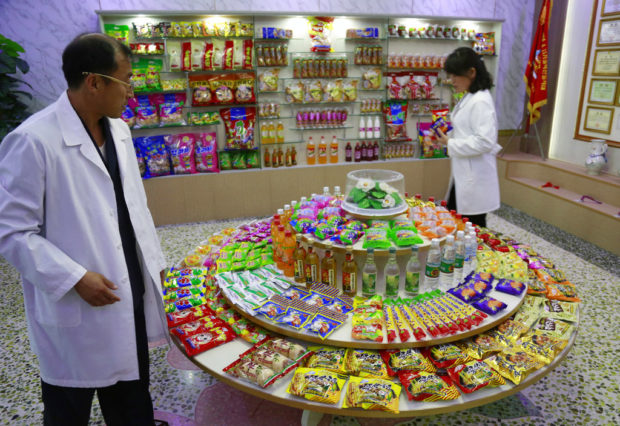
In this Oct. 22, 2018, photo, Kwon Yong Chol (left) the chief engineer at the Songdowon General Foodstuffs Factory, shows samples of products at his facility in Wonsan, North Korea. AP
WONSAN, North Korea — For North Korean factory managers, a visit by leader Kim Jong Un is the highest of honors and quite possibly the most stressful event imaginable.
The chief engineer at the Songdowon General Foodstuffs Factory had looked forward to the visit for nearly a decade. His factory churns out tons of cookies, crackers, candies and bakery goods, plus dozens of varieties of soft drinks sold around the country. In its showroom, Kwon Yong Chol proudly showed off one of his best-sellers, a nutrient soup made with spirulina, a blue-green microalgae “superfood.”
“Ever since construction began everyone here had wanted the leader to visit, and this year he did. His visit was the biggest thing that could happen to us,” Kwon, smiling broadly, said of Kim Jong Un’s visit in July. “He ate our instant noodles. He said they were delicious.”
Not all managers have been so fortunate.
There’s a lot on the line for North Korea these days. And Kim means business.
Though the international spotlight has been on his denuclearization talks with Washington, the North Korean leader has a lot riding domestically on his promises to boost the country’s economy and standard of living.
His announcement in April that North Korea had sufficiently developed its nuclear weapons and would now focus on building its economy marked a sharp turn in official policy, setting the stage for his rapid-fire meetings with the leaders of China, South Korea and the United States.
It also set in motion an ambitious campaign of “on-the-spot guidance” trips to rally party officials, factory managers and military troops.
After the announcement of the “new strategic line” and his first round of summits, including his meeting in June with President Donald Trump, Kim embarked on nearly 20 inspection tours around the country in July and another 10 in August, all but one of them to non-military locations. The military inspection rounds are instead being handled by the country’s premier, Pak Pong Ju, who has gone on 18 inspection tours from July, mostly to military facilities.
On-the-spot guidance tours are a tradition Kim inherited from his father and grandfather, the late “eternal General-Secretary” Kim Jong Il and “eternal President” Kim Il Sung.
They date to the late 1940s, when Kim Il Sung began gradually institutionalizing the visits to demonstrate his hands-on leadership and, as invariably portrayed by the North’s media, his deep care and concern for the well-being of the people.
Factories, farms and important industrial facilities are the usual destinations. But Kim Jong Un’s focus on them this year marks a break from excursions in 2017 to nuclear weapons facilities and missile sites.
Reflecting the gravity of his current mission, Kim has shown little patience for cadres who come up short.
On his July tour in the northern part of the country he lambasted officials at a factory that produces backpacks for students, saying their attitude was “very wrong” and “has no revolutionary spirit.” He then dressed down officials at a power plant that has been under construction for 17 years, criticized people in charge of a hotel project for taking too long to finish plastering its walls and slammed the authorities responsible for building a recreational campsite.
“Looking round the bathroom of the camp, he pointed out its very bad condition, saying bathtubs for hot spring therapy are dirty, gloomy and unsanitary for their poor management,” said an official report of the visit. /ee